Menus
- Up to 150 hp
- let the games begin
- Motor – which one has the best drive?
- Chassis – steel chassis vs. Aluminum frame
- Everyday life – seating position, pillion passenger & Co.
- Safety – brakes and assistance systems
- Cost – which bike is the cheapest?
- Conclusion – newcomers or proven material?
- MOTORCYCLE overall result
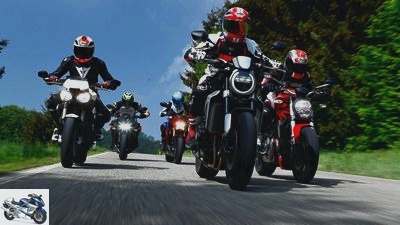
fact
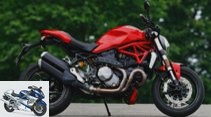
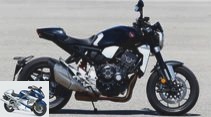
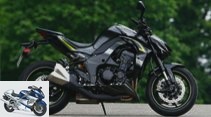
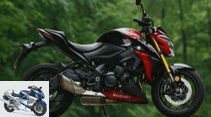
27 photos
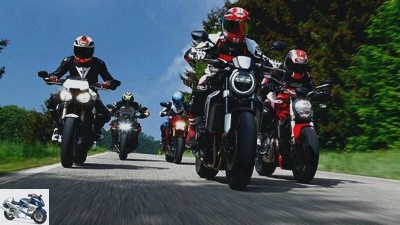
1/27
Ducati Monster 1200, Honda CB 1000 R +, Kawasaki Z 1000 R Edition, Suzuki GSX-S 1000 and Triumph Speed Triple S in comparison test.
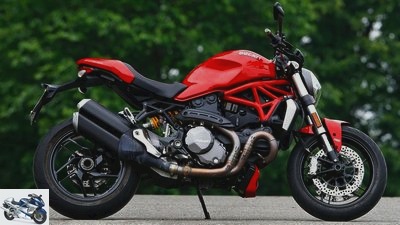
2/27
Ducati Monster 1200: Be embraced, cylinder: concise, arm-thick manifolds meet unmistakable lines. Fiery: Italian red.
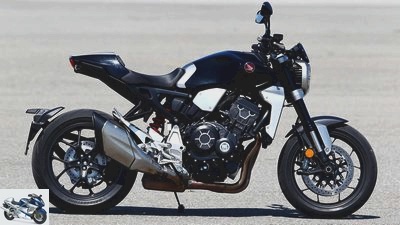
3/27
Honda CB 1000 R +: Extravagant with lots of brushed aluminum, the noble version “Plus” of the naked Honda, which is also ennobled with a single-sided swing arm, has a look.
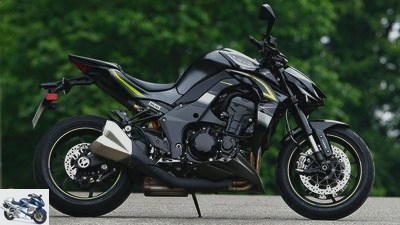
4/27
Kawasaki Z 1000 R EDITION: 1500 euros surcharge on the standard Zett costs the “R Edition” with a higher quality chassis and snappier Brembo brakes.
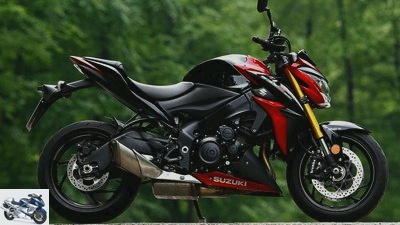
5/27
Suzuki GSX-S 1000: The engine of the 2005 GSX-R 1000, the “K5”, lives on in a bare powerhouse. By far the cheapest offer from the quintet!
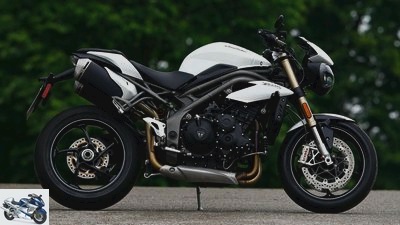
6/27
Triumph Speed triple S: The British icon started the 2018 season sharpened. Stronger and much better equipped than ever before. Gentleman fighter!
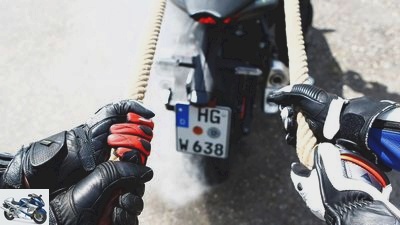
7/27
The engine check: Is it really more than necessary on country roads
80 HP for great driving pleasure? Certainly not. But … it’s hotter!
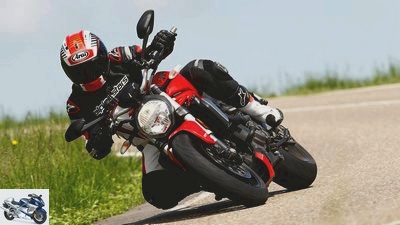
8/27
Ducati Monster 1200. The price for the great agility of the Duc (wide handlebars!) Is a certain fidgety, especially on wrinkled asphalt.
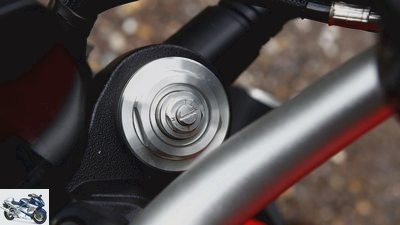
9/27
The correctly set rebound stage of the fork doesn’t change anything. The powerful V2 still requires a lot of manual work.
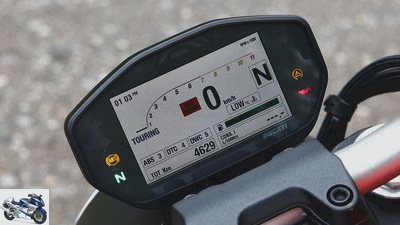
10/27
Colorful and high-contrast: TFT display.

11/27
The chassis check: Are these five candidates also “good on their feet”? There are two factions in the game – steel chassis or aluminum frame.
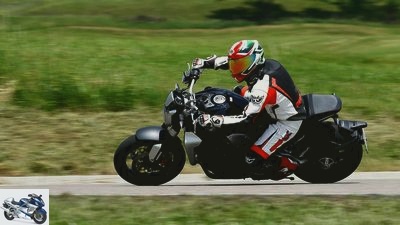
12/27
Honda CB 1000 R. The Honda is also a real cornering artist. It drives easily and precisely, remains reasonably stable. A little early (er) their pegs scratch.
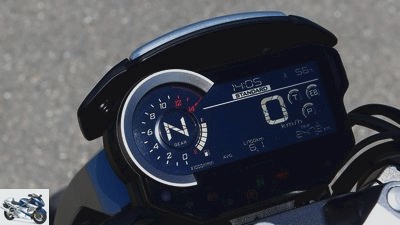
13/27
Playful: LCD cockpit behind a small umbrella.
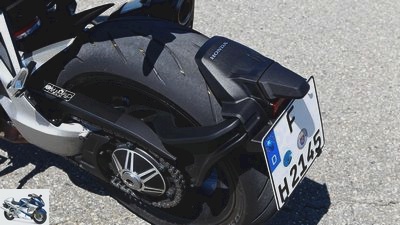
14/27
Single-sided swing arm with a beautiful sprocket carrier and license plate holder.
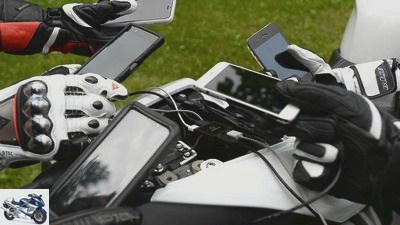
15/27
Not just naked cannons and fun grenades. The everyday check.
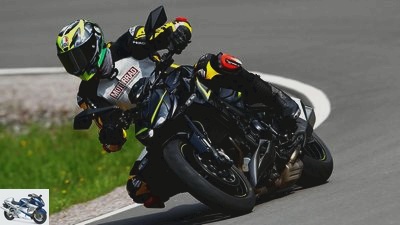
16/27
The Kawasaki Z 1000 R Edition is very full on the road, offers a good compromise between stability and comfort.
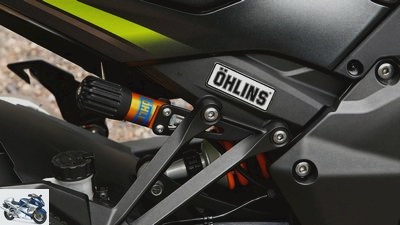
17/27
Which is also due to the Ohlins shock absorber of the Edition version, which can be adjusted in rebound and preload.
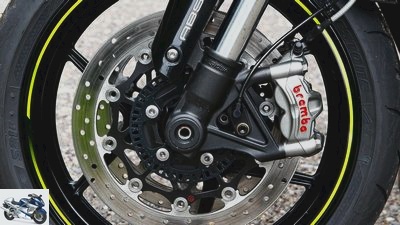
18/27
That bite: The Z’s stoppers are a force.

fact
19/27
Safety first! Brakes and assistance systems in the safety check.
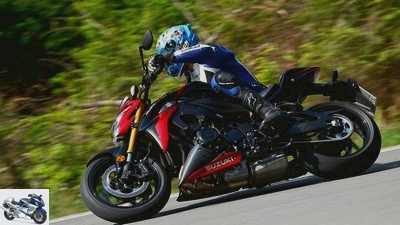
20/27
The Suzuki likes curves, but only when it comes flat as a rock around the corner. The response of the shock absorber to distortions can still be improved.
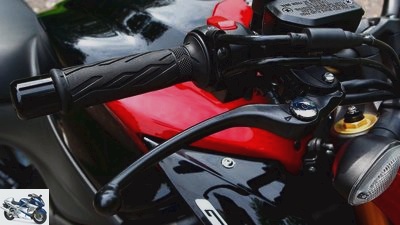
21/27
Radial product for the right hand, but the brake responds bluntly.
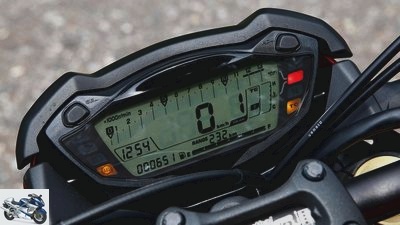
22/27
Sober: the LCD cockpit of the GSX-S 1000.
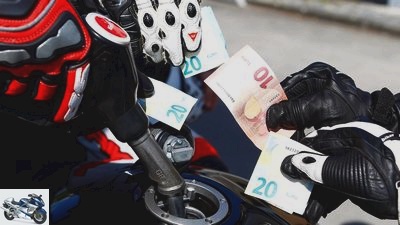
23/27
What does the world cost? … Or the new bike from the perspective of running costs?
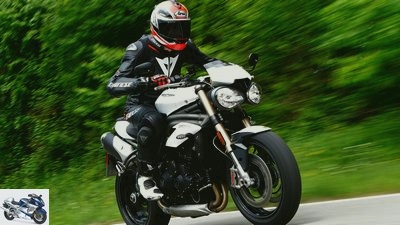
24/27
The Speed Triple S combines a fine response behavior of the suspension elements with a lot of stability and great maneuverability – a splendid country road motorcycle.
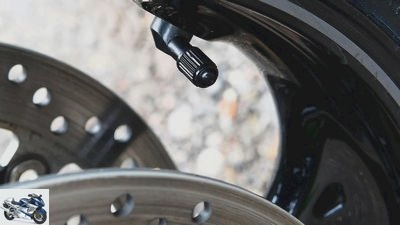
25/27
The cranked valve facilitates air pressure control.
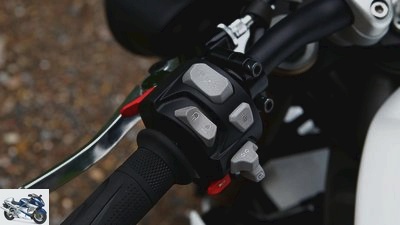
26/27
The cruise control is only available from her.

27/27
730 PS rush through the green of early summer. But who has the edge in the end??
5 power naked bikes (2018) in a comparison test
Up to 150 hp
These naked bikes up to 150 hp offer pure riding pleasure: five distinct two-wheeled personalities invite you to character studies. Triumph has tightened its Speedy, Ducati, Kawasaki and Suzuki have hot irons in the fire. And where does Honda’s cool CB 1000 R in the noble “Plus” version fit in? Helmet on, engines on!
S.he is the spark of our motorcycle passion, the fuel of the two-wheel fascination, the icing on the cake: curves. They give desire a direction, direct the fore-drive, circle the hill, climb the mountain, storm the sky. They lead us down to the valley, bring us home or far away. These turns in the course of the road, left, right and again from the front, stand for life itself. Of course, curves can be enjoyed on a naked bike in the pure teaching: no window, no cladding filters the clear sensation. Pure passion applies here, the unadulterated driving pleasure. Engine, wheels, seat and tank, done.
Buy complete article
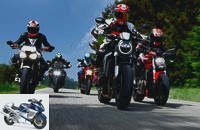
5 power naked bikes (2018) in a comparison test
Up to 150 hp
A lot has happened with the roadsters
Three different engine concepts – V2, in-line three- and four-cylinder – embody different origins and characterize brand philosophies. A lot has happened in the roadster class up to 150 hp: Honda is launching a completely turned inside out CB 1000 R. It is nominally strengthened by 20 to 145 HP – and with a new frame it is the flagship of the in-house Naked Bike series with the sonorous design name “Neo Sports Cafe”. Extravagant, but very harmonious look meets noble materials. This is especially true for the luxury version with the plus: With it, heaps of attachments made of brushed aluminum top the fine finish. Delicious. It also has heated grips as standard, as well as a shift assistant that masters upshifting and downshifting.
730 PS rush through the green of early summer. But who has the edge in the end??
From the world’s largest to the three-cylinder manufacturer: Triumph has upgraded its icon called the Speed Triple. Full roar now comes from the engine room, a whopping 150 instead of 140 hp. A power boost through a new cylinder head with optimized ducts, camshafts with more lift, harder valve springs, new pistons and higher compression. The triple peripherals became lighter: alternator, primary drive, clutch, balance shaft and battery. Everything is garnished with a tilt-adjustable TFT cockpit, illuminated switches, cruise control, LED daytime running lights and a USB charging socket.
let the games begin
A remodeled Monster 1200 has been rolling in from Bologna since 2017 (g). The 1198 Testastretta V2 should guarantee a whopping 147 hp. Extensive electronic helpers including cornering ABS and multi-level traction and wheelie control in four driving modes are a matter of honor at Ducati. At Kawasaki, this applies to an “aggressive design” with an evil line. Especially in the flagship Z 1000.
fact.de
Each of the five naked bikes has its advantages. But which one wins the comparison test?
It already received LED headlights, gear displays and a new upside-down fork last year. Everything topped in the “R” edition: It anchors with Brembo M50 monoblock brake calipers, actuated by steel flex lines, springs and dampens with Ohlins strut in the rear and has a modified seat and additional stickers. And Suzuki? Typically for Japan, it has a mighty four-cylinder on offer, the modified Ex engine from the GSX-R 1000 K5. The strong guy has been getting new honors in the GSX-S for years. Technically everything remains the same here – new developments are few and far between at Suzuki. There are thousands of them at a special price. Nice too. Well, let the competition begin, the struggle for the title of “best naked bike”.
Motor – which one has the best drive?
Hand on heart: Do you really need more than 80 hp for great driving pleasure on country roads? Certainly not. But it’s even better when you have reserves at all times when the feeling of unrestrained power is on board. Clear the stage for the heart of the five nakeds. Power is based – in addition to the speed – on the displacement and number of cylinders. As there are: twin, triple and three four-cylinder; 1198 cm3 (Ducati), the midfield with 1050 (Triumph) and 1043 cc (Kawasaki) and the two real thousands from Suzuki and Honda.
The Monster Twin has the largest volume, by far the largest single cubic capacity. The two 106 pistons slam like two huge hammers, piling up to 121 Newton meters and 145 hp on the quintet’s narrowest crankshaft. The whole thing is accompanied by a particularly bassy sound. The two silencers on the right snort and trumpet a little loudly with joie de vivre, even when pushing. Paddock attitude for petrolheads.
The Monster V2 develops 145 hp.
When the V2 really pops in the middle, you shout with happiness. At 6,000 tours the Ducati already lifts a whopping 110 Newton meters, while the Honda leaves it with a gentle 80 Nm. This fullest torque curve guarantees high entertainment value. The monstrous V2 made of two 600 cubic cylinders only rotates a good 3,800 tours at 100 km / h thanks to a very long overall ratio in sixth gear. The downside: the largest of the five engines is often downshifted. On country roads you always drive one gear lower than with the rest of the quartet. To which the jerky, uneven engine running below 2,500 tours contributes its part. In percentage terms, the V2 is designed to be particularly short-stroke. Its exclusive hydraulic clutch requires the greatest manual strength in the field.
Triumphs Speed Triple S has the largest stroke, both in absolute terms and in percentage terms – good for perfect concentricity and power from below. And in fact the triplet presses in the lower speed range, up to almost 4000 revs, even more powerfully than the Ducati V2. And from then on, the Triple never lets the butter off the bread: its performance curve is almost congruent with that of the monsters over almost the entire engine speed range. In order to then mercilessly cushion them beyond the 8,500 tours. Real 154 hp mean the highest peak performance of the driving fun quintet. Not bad for the oldie – its basic design is based on the Sprint ST 1050 from 2005. The modifications made in 2018 pay off.
The Triumph engine impressed in the test.
The legendary Speed Triple benefits from the 1,000 revs higher speed limit and hits the top like a hooligan – with super punch. But is gallant and polished as if fresh from diplomatic school. The gear ratio fits perfectly, the sixth gear corresponds to the fifth of the monsters. In addition, there is the one-finger clutch and the silky smooth running of all five machines. Acoustically, the growling three-cylinder is always present, but never annoying. The hissing of the two old fashioned high exhaust pipes blow dry the cilia. In addition, it scores with the lowest consumption. The triple is a stunner, just the golden mean!
Come to Kawasaki, it used to be said. Your four-cylinder lures with a pleasantly dull, grim sound. Typical for the smallest Japanese brand: the fairly increased idle speed after a cold start. She marches, the Zett, and how! Can be moved very flexibly at 45 km / h in sixth gear. And shortly thereafter, fireworks set off: It is in sixth gear after a spectacular 5.9 seconds from 60 to 140 km / h, and from 60 to 180 after just nine seconds. Pulling miracle or surface-to-surface missile? The performance curve lies exactly in the middle, between the two Europeans and the rest of the Japanese. The secret of Kawasaki’s power regimen? The extremely short overall translation.
In the comparison test, the R-Varainte of the Kawa was allowed to prove itself.
As with the Suzuki, the sixth gear turns higher than the fifth of Ducati and Triumph: 4700 times for 100 km / h. You are always looking for a seventh gear. What is also due to the extreme, annoying vibrations in the second half of the speed: They crawl everywhere, in the tank flanks, handles and footrests, making the Z 1000 R a tingling Kawa. With all the power, the Zett consumes the most fuel. And be careful: the rear wheel can sometimes come across when exiting a curve because traction control is still missing.
The Suzuki foursome also has a dull and hoarse gasp, sounds great. It accelerates brutally: smooth three seconds from zero to 100, only 8.5 to 200. If you can do it right. And even the torque values are better than with Ducati and Triumph. A real power pack with a whopping 148 hp. However, like the Z 1000 R, it vibrates quite well. Better than Kawa and Suzi, the Honda hangs on the gas, finer, more direct and yet more gentle out of rolling phases. Compliment. However, the torque does not even come close to that of the equally large GSX four-cylinder. It almost always presses ten to 15 Newton meters more.
Honda’s new CB 1000 R attracts attention with its extravagant look.
The result: The extremely compact, 139 hp Honda engine seems almost a little anemic in this sovereign environment, always trying. He needs speed. The other four convey the feeling of irrepressible power more clearly. On the positive side: the low-load change CB 1000 R + is – entirely Honda – a feel-good motorcycle. It does not keep inciting people, is not so pointed towards heating at any price. Nice for the nerves. And it still allows high joy wheelies in levels one and two of the three-level traction control.
Result rating engine
1. Triumph Speed Triple S (204 points)
2. Suzuki GSX-S 1000 (198 points)
3. Ducati Monster 1200 (194 points)
4. Kawasaki Z 1000 R Edition (193 points)
5. Honda CB 1000 R + (190 points)
Chassis – steel chassis vs. Aluminum frame
We continue with our character studies. Are these five candidates also “good on foot”? Do you carry effortlessly working spring elements, are your chassis nicely stable? Philosophy or question of faith: There are two factions here. One comes with a steel chassis, while the other uses an aluminum frame. What draws?
The Suzuki is by far the cheapest bike in the test field.
Ducati traditionally relies on striking, steel tubular meshes. Honda also uses steel, which is easy to machine and easier to repair. Kawasaki, Suzuki and Triumph use aluminum frames. The Z 1000 R Edition carries the light metal, like the CB 1000 R + in steel, as a backbone frame. It integrates the motor from above in a supporting manner. GSX-S 1000 and Speed Triple S rely on aluminum bridges that connect the steering head and swing arm mount over a short distance, along the side of the engine. A trademark is the Speedy frame, artfully welded together from many individual parts.
The faster, the better – the name Speed Triple fits. Wonderfully handy, unshakably stable and extremely precise, precise like a mathematical formula, the Triumph sweeps through the curves. Your spring elements offer plenty of reserves. But be careful: Pirelli Supercorsa SP are not for wet conditions. Triumph and Honda both weigh 214 kilograms. The CB 1000 R + gives you a feeling of wonderful light-footedness. It can be tossed back and forth playfully, drives balanced, neutral and very good-natured, even good for people with less driving experience. Your Bridgestone rear tire S 21 “M” in the modern 190/55 cross-section adheres well and rolls wonderfully round, right up to the edge of the tire.
Even in the rain, the Japan tire gives you a lot of confidence. The CB 1000 R + cannot completely deny its directly articulated shock absorber, as with the Monster. It stucks on uneven road surfaces in an inclined position. The 219 kilo Ducati with its wide handlebar shows this phenomenon even more clearly. Then she becomes a fidget. The Gabel clearly does its management tasks better on gourmet asphalt. Is that the price the monster pays for its pronounced agility? The fact is: The M1200 takes more getting used to than the rest of the quartet. But then it’s really good fun. All Ducati.
Which naked bike is ahead in the chassis category??
The Kawasaki in Manga design is tame and well mannered. She is fed up. The easy-to-swallow Showa fork and the Ohlins shock absorber of the R-Edition take a lot, digest even parforcer rides over badly pitted tar. Great. The Zett holds its line precisely. Bridgestone S 21, in the back as 190/50, harmonize perfectly with the powerful Kawa. It only affords itself a touch more set-up moment. In addition, the little bag in the test field (222 kilograms full) turns in a little less willingly.
The 212 kilo Suzuki is a real cornering artist. However, its unplaned shock absorber is woody and insensitive. Even completely relaxed, it hits the back hard on mogul slopes. Then there is a hole in the fun. And the Dunlop Sportmax D 214 tires in the special specification “M” look a bit old.
Result evaluation chassis
1. Triumph Speed Triple S (192 points)
2. Kawasaki Z 1000 R Edition (186 points)
3. Suzuki GSX-S 1000 (183 points)
4. Honda CB 1000 R + (180 points)
5. Ducati Monster 1200 (172 points)
Everyday life – seating position, pillion passenger & Co.
USB connections do not make a difference in the scoring, but their presence shows that the bare cannons want to be more than just fun driving grenades, they have also made a point of common sense. Being able to charge your own smartphone – a helpful and useful feature if you run out of juice on the go. Much more essential, however, is: How do you sit on the five donors of joy? And there is good news in a moment. Everyone is comfortable, even if they bed their pilots quite differently.
fact
How do the bikes fare in everyday life??
The Honda succeeds most comfortably. The CB 1000 R + integrates its pilot loosely and flaky in its center, and that almost entirely regardless of size or stature. Narrow knees, quite high handlebars, plus a knee angle that is suitable for long distances – you like to sit down and endure it for a long time if necessary. However, the sitting position also has its downsides, at least if you get the sporty spirit. Because of the tall and rather narrow handlebars, the Honda rider simply puts a little little pressure on the front wheel, the feedback from which is low because of the upright sitting position.
The CB 1000 R + would do better with more feedback when dancing briskly around corners and bends. The Triumph shows how it can be done differently, i.e. crisper and yet almost as comfortable. Thanks to the flat handlebar, more weight automatically moves forward. This means slight compromises in terms of comfort, but it is a clear advantage for the feeling of driving. Right in the middle between the small extremes Honda and Triumph are the Suzuki and the Kawasaki when it comes to sitting, whereby the Suzuki with a slightly larger knee angle and the slightly longer cushion offers more variance when sliding back and forth.
The Ducati’s TFT display impresses with its high-contrast representation.
That leaves the monsters. Everything is right on her too. However, the rider sits more in the motorcycle than on the motorcycle, and long feet can sometimes come into conflict with the pillion footrest extensions when the boots are to be put backwards in a sporty way. Then it pushes the heels outward uncomfortably. A penalty that the Kawasaki Z 1000 R also knows, albeit a little mitigated. With the three other motorcycles, the feet have enough space and can be positioned in front, in the middle or at the back of the pegs as you like.
Until now the focus was on the driver, now the pillion rider is in charge. The most comfortable way to travel is on the Ducati. Whereby the ten out of 20 possible points are not a real glory sheet under this aspect. But the Italian is best suited for short trips for two, at least when it comes to comfort for the very best and contact with the driver. With the others in the quintet, narrow knee angles or tight cushions noticeably limit the comfort of the passengers. You can tell that the look has clearly triumphed over the function. The most extreme example of this is the Honda. After the minimalist pillion cushion, there is immediately nothing when the rear ends. The Z 1000 R, GSX-S 1000 and Speed Triple S do not restrict pillion transport quite as radically.
The Honda drives easily and precisely, remains reasonably stable.
When the sun slowly tends towards the horizon after a trip for two, the naked bike fan is happy about the bright lights on the front, which illuminate the road well. Honda, Suzuki and Triumph have heard this wish, their bright headlights illuminate the surroundings and the road effectively. The light dispensers of the Ducati and Kawasaki do not shine as brightly. With the Kawasaki Z 1000 R – as with the pillion seat – this is primarily due to the design. The two LED lights in the grim front mask are primarily supposed to impress visually and not turn night into day.
An Achilles heel then unites all five again. We are talking about luggage storage. Indeed, this aspect should not play a major role in a purchase decision. Anyone who wants to haul something away is better off with luggage rack decorated travel enduros and similar bikes. But not being able to lash anything at all is not the solution either. If the roll of luggage is to move to the pillion seat for the upcoming trip with your buddies, you need a hook or two. The Honda completely dispenses with something useful, with the others at least the pillion pegs have lashing options, the pillion benches of the Suzuki and Triumph offer extra loops for attaching luggage. Nevertheless: Without a good portion of brainpower and some skill, luggage cannot be attached to any of the naked bikes in no time at all.
The Kawa offers a good compromise between stability and comfort.
Anyone who talks about luggage must also talk about the payload. The Ducati exhausts the fastest, 171 kilograms mark the lowest value. The others should pack more: 179 kilograms the Kawasaki, 188 kilograms the Honda and Suzuki, and the Triumph even transports four hundredweight if necessary. And that for a long time. After all, she sips the precious juice in the tank quite modestly. The Briton treats herself to 4.5 liters per 100 kilometers. However, the Suzuki is the range champion with 370 km, thanks to the large 17-liter tank and low consumption of 4.6 liters. The rest of them have to go to the next gas pump sooner. Such differences cannot be found in the processing quality of the Power-Naked. Regardless of whether the scoring spits out 14 or 15 points – they all easily withstand the strict and scrutinizing look into the smallest of corners, and convince with a high level.
Result evaluation everyday
1. Triumph Speed Triple S (143 points)
2. Suzuki GSX-S 1000 (142 points)
3. Ducati Monster 1200 (139 points)
3. Honda CB 1000 R + (139 points)
5. Kawasaki Z 1000 R Edition (132 points)
Safety – brakes and assistance systems
Safety first – now the focus is on safety. The safety vest is not mandatory, but strong brakes and effective assistance systems are. What do the five have to offer? Here are the details.
One look is enough. If you turn your eyes towards the brake components at the front, you will only see the finest goods. Radial hand pumps are just as standard on all five as radially mounted brake calipers. We like to see that. And yet: when reaching for the adjustable lever on the right, which can be adjusted in width, there are noticeable differences.
Safety first!
The sportiest – because the crispest – Kawasaki chose the front stoppers. Two fingers are sufficient for anything and everything, and in most cases even the pressure of the index finger is enough to slow the Z 1000 R into the ABS control range. The nice thing about it: The dosability does not suffer from this coordination. She masters the game with the currently desired deceleration performance around the stable pressure point with flying colors. Regardless of whether it is just a matter of reducing a few kilometers an hour or precisely hitting the braking point before the next bend, the Kawasaki can do both. If you switch from one of the other motorcycles to the Z 1000 R, you will probably have to get used to the brilliant grabbing of the stoppers, simply because the brakes respond so spontaneously and splendidly.
Conversely, this also means: The stoppers on the other motorcycles don’t work quite as hard, those on the Suzuki are almost a little too cautious compared to the Kawa. With these brake pads – it can’t be because of the rest of the components – they made a very blunt choice in Hamamatsu. The effect works, but the hand strength for the research stop is high, and the controllability also suffers from the wooden response. As I said: other rubbers would probably help.
The brakes of the Kawasaki were able to convince in the test.
The Monster, CB 1000 R + and Speed Triple S don’t need them. The Triumph in particular comes close to the Kawasaki in terms of braking performance, while Ducati and Honda are a noticeable distance behind. The bottom line is that the pistons of all pliers pinch more than enough into the double discs on the forks, which measure at least 310 millimeters, and reliably bring every motorcycle to a standstill. Now it’s worth taking a look at the assistance systems. There are counters for adjustable driving modes, the function of traction control, the ability to adjust the ABS, or if an automatic gearshift is part of the equipment. The other aspects such as hill hold, cornering lights and the like are irrelevant for the quintet because they simply do not exist.
And when it comes to not owning something, the Kawa raises her hand most clearly. An ABS has been a mandatory standard since the introduction of the Euro 4 norm, but the Z 1000 R cannot do more with it. Love it or leave it. The strong four-in-line provides more than sufficient arguments for a happy relationship, but it also clearly shows that traction control would suit him well. As with all others, its power output can be infinitely adjusted with the right hand, but the throttle position and the required power do not always perfectly match the street scene. An overlooked spot, a slight bump, and the Z 1000 R noticeably jerks to the side, announces the spontaneous liability limit of the Bridgestone S 21. More electronics in the form of a TC would be a blessing and not a curse here.
The brake of the Suzuki responds rather bluntly.
This also applies to the scoring. Because: every time the Z 1000 R has gained a lead with its great brakes, it loses it again because of the zero number in the assistance systems. All others offer more under this aspect, starting with the Suzuki, which has to get along without adjustable driving modes, but has an effective TC that can even be deactivated. The monster turns out to be a point collector because, in addition to various settings for traction control, it also comes with different ABS modes. The driver can even switch off your anti-lock device. This is also possible with the Triumph, but it only has the ABS variants on or off.
Like the other motorcycles of Japanese origin, the Honda doesn’t want to know anything about that. Your ABS is always activated. The CB 1000 R + is the only one to carry a blipper for upshifting and downshifting without clutching the clutch. It works splendidly and gives the Honda a few extra points, which is why, like the Triumph, it only lands just behind the Ducati when it comes to assistance systems. A good keyword for the entire section is safety, which the Triumph wins with 114 points. The Suzuki lands behind with 105 points. The difference remains small. Which also shows: When it comes to the most important aspects of braking, none of them afford any weaknesses, braking steadfastly even with a pillion passenger right into the ABS area, which is effective and well-regulated for everyone. Hitting the handlebars is not really an issue for the naked either, which is why the details described ultimately tip the scales.
Result rating security
1. Triumph Speed Triple S (114 points)
2. Ducati Monster 1200 (113 points)
2. Honda CB 1000 R + (113 points)
4. Kawasaki Z 1000 R Edition (106 points)
5. Suzuki GSX-S 1000 (105 points)
Cost – which bike is the cheapest?
Before the piggy bank bursts into a thousand pieces on the coffee table, the home loan and savings contract is canceled or the next loan is taken out, the following question has to be answered: For whom is it most worthwhile to pull out the wallet, purely from the point of view of running costs?
Friendship ends when there is money, the fun ends. Only pure facts count. And by and large they can be summed up with the simple formula “What does the fun cost?” It was already clear that they would not count as special offers. With powers above 100 hp, it is foreseeable that the motorcycles will require new tires after a few thousand kilometers. Thanks to adequate consumption, they can cover the 100-kilometer distance if necessary without being too thirsty.
Which bike tears the smallest hole in your wallet??
The Triumph sips the most expensive juice in its tank: ideally, 4.5 liters are enough to travel 100 kilometers. The others treat themselves to a little more for the same task. The Suzuki requires 4.6, the Ducati 4.7, the Honda 4.8 and the Kawasaki 5.1 liters. This is mainly due to the short overall gear ratio of the Kawa, which always turns higher than the rest at the same speed. The Kawa driver also has to reach for his wallet more often when it comes to inspection costs, after all, the workshop wants the Z 1000 R to be checked every 6,000 kilometers see. The remaining gang of four can take more time between the individual maintenance appointments. The Triumph dealer asks for an inspection every 10,000 kilometers, the Honda and Suzuki workshops every 12,000 kilometers, and the trusted Ducati mechanic only wants to inspect the monsters every 15,000 kilometers.
It is right that all manufacturers call for an annual service if this mileage is not achieved. Ultimately, however, its scope does not allow a meaningful assessment because no dealer advises its customers to check valve clearance, for example, if the bike is still a long way from the 10,000 mark on the clock even after three years of operation. In addition: On the one hand, with the new H2 SX, Kawasaki shows that inspection intervals of 12,000 kilometers are possible, and on the other hand, the stored work values per inspection still largely determine the final assessment.
The win in the cost category goes to the Honda CB 1000 R.+.
With the Z 1000 R, these easily exceed 20 hours over a distance of 60,000 kilometers, while Suzuki specifies less than ten hours of inspection time. Whether these are to be held in individual cases is another matter. Be that as it may: When it comes to inspection costs, the Z 1000 R ends up in the back, which ultimately spoils it for a better placement. That is a bit of a shame because otherwise it is very tight.
When looking at the financial situation, the Honda and Suzuki turn out to be the first choice for stingy two-wheeled fans. The two Europeans follow closely behind. Which has its good points, after all, you can be sure that your driving pleasure will not be eaten up by the costs.
Result evaluation costs
1. Honda CB 1000 R + (63 points)
1. Suzuki GSX-S 1000 (63 points)
3. Ducati Monster 1200 (62 points)
3. Triumph Speed Triple S (62 points)
5. Kawasaki Z 1000 R Edition (51 points)
Conclusion – newcomers or proven material?
Head-to-head race or straightforward, newcomer or proven material? Who is in the lead at the end is no surprise. Even so, there are almost only winners.
The result seems scratched: The famous Triumph Speed Triple S wins four out of five rating chapters! Tusch, congratulations on the terrific test victory. The superior test winner Speed Triple S is not that expensive, inspires in the stomach and convinces even the head. Nevertheless, the conclusion has to be more complex and multi-layered. Because here five fine motorcycles meet. Even in the 1000-point rating, the gap isn’t that big: Okay, 47 points difference seems like a lot at first. But if you weight all criteria equally, we’re talking about a maximum of seven percent difference. It is difficult to punish one of the five candidates.
730 PS rush through the green of early summer.
Translated into the extremely important price-performance ratio, this means: Typical of the brand, the Suzuki is ahead. It is the recommendation for bargain hunters for both purchase and maintenance. However, no tip at all for bad roads. Ducati, Honda and Kawasaki are also worth their money. Compliments on the boldly designed design of the very homogeneous Honda. If you want to take your loved one with you more often, you should consider the Ducati.
But which ones to buy now? Far away from all point grids, there is of course a lot of feeling here. In other words: whoever likes the primal scream of the V2 will never want to deal with softly whispering row fours. And it also has to be right right away when you try to sit. The grip on the handlebars, the feet on the notch, the view of the cockpit. With a difference of 47 points, the famous gut decision can be the deciding factor. And when it hits the trusted dealer – it can’t get any better.
MOTORCYCLE overall result
1. Triumph Speed Triple S (715 points)
2. Suzuki GSX-S 1000 (691 points)
3. Honda CB 1000 R + (685 points)
4. Ducati Monster 1200 (680 points)
5. Kawasaki Z 1000 R Edition (668 points)
Related articles
-
Comparison test of mid-range naked bikes over 100 hp
31 pictures 1/31 Yamaha MT-09 SP, Kawasaki Z 900, Triumph Street Triple R, KTM 790 Duke, Ducati Monster 821 and Suzuki GSX-S 750 …
-
fact 44 pictures fact 1/44 Aprilia Tuono V4 1100 Factory, BMW S 1000 R, Ducati Monster 1200 R, Honda CB 1000 R, KTM 1290 Super Duke R, Triumph Speed Triple …
-
Middle class naked bikes in comparison test
r-photography.info 30 pictures r-photography.info 1/30 With the Z 900 Kawasaki pushes the middle class close to the full liter. Looks up …
-
Nine power naked bikes in a comparison test
fact 57 pictures fact 1/57 Simple, good: excellent readable instrument cluster with analog tachometer and the most important digital. fact 2/57 The …
-
7 power naked bikes in a comparison test
Gargolov 54 pictures Gargolov 1/54 Power-Naked-Bikes. That sounds like purism, like motorcycles that don’t have more than necessary. Gargolov 2/54 The …
-
Comparative test of naked bikes 2013
fact 37 pictures fact 1/37 Aprilia Shiver 750 ABS, Triumph Street Triple 675, Suzuki GSR 750, Kawasaki Z800, Yamaha FZ8, MV Agusta Brutale 800 and BMW F …
-
Comparison test of naked bikes from Japan
Art 15 pictures Art 1/15 Art 2/15 Art 3/15 Art 4/15 Art 5/15 Art 6/15 Art 7/15 Art 8/15 Art 9/15 Art 10/15 …
-
Power Naked Bikes in Comparison – Part 2
31 photos 1/31 BMW S 1000 R, Honda CB 1000 R, Kawasaki Z 1000, Suzuki GSX S 1000 and Yamaha MT 10 in the comparison test….
-
Comparison test of naked bikes
Comparison test of naked bikes indivi-duel Buell or Triple, Guzzi or Buell. Three extroverted companions are up for debate. All just one …
-
Comparison test of naked bikes with three-cylinder engines
fact 50 pictures fact 1/50 This swelling, threatening screeching is not about a squadron, but about the five …